The best apple cider vinegars are organic, unfiltered and raw (unpasteurized).
I personally use scraps (peels and cores). This way I get to eat my apples and make vinegar too. Or if you are making a pie or apple sauce… instead of throwing away the scraps, you can start making your first vinegar.
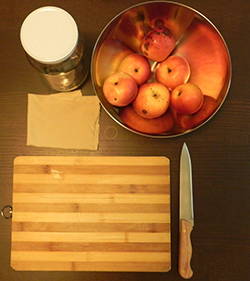 You’ll need:
You’ll need:
- apple peels, cores and any browning/discolored flesh from pesticide-free apples (I used only 3 of them)
- one large jar (for fermentation) and another one to let the vinegar rest
- a rubber band
- Cheesecloth or floursack cloth
- Honey or granulated sugar
- Water
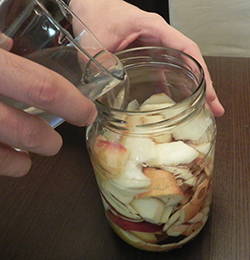 Peel the apples and fill you container by at least half way with your apple scraps (peels & cores), seed, stems and all. If at least half the container is not filled, add additional apple scraps until you achieve this level as a minimum.
Peel the apples and fill you container by at least half way with your apple scraps (peels & cores), seed, stems and all. If at least half the container is not filled, add additional apple scraps until you achieve this level as a minimum.
Make sure the pieces are big enough to strain out easily later (no puree).
Pour in room temperature (filtered) water until the chopped apples are completely covered and the container is just about full leaving 1-2 inches at the top.
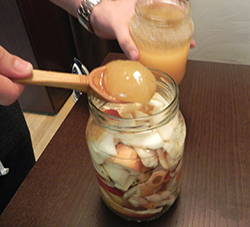 Stir in the raw honey or cane sugar until fully dissolved.
Stir in the raw honey or cane sugar until fully dissolved.
Optional: you may add yeast to speed up the process of fermentation (Special cultivated yeasts are available for this purpose at wine-making shops).
Tip: You could use raw apple cider vinegar to jump start this fermentation, use 2 Tablespoons per quart.
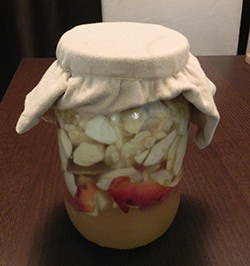 Cover the top of the glass jar with cheesecloth, a thin white dishtowel or floursack cloth and secure with a large rubber band.
Cover the top of the glass jar with cheesecloth, a thin white dishtowel or floursack cloth and secure with a large rubber band.
Stir the mixtures daily. Keep the containers away from direct sunlight and maintain the temperature at 60 to 80 degrees F.
The healthy bacteria that create vinegar require oxygen for the process, so it is important not to seal the container with a lid until the vinegar is as strong as you want it to be.
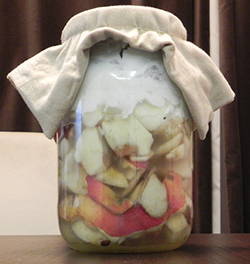 Leave on the counter for about 1 week.
Leave on the counter for about 1 week.
Bubbles will begin to form as the sugar ferments into alcohol.
As you can see it did some bubbles – a good sign that bacteria had eaten the sugars and had produced carbon dioxide in this process (aka fermentation)
When the apple scraps no longer float and sink to the bottom of the jar (see picture) after approximately one week (but it can take 2), the hard apple cider is ready.
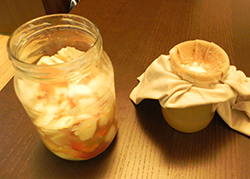 Strain out the apple scraps and pour the hard apple cider into another glass jar.
Strain out the apple scraps and pour the hard apple cider into another glass jar.
Cover with a fresh piece of cheesecloth and secure with a rubberband. Leave on the counter in an out of the way spot for an additional 3-4 weeks to allow the alcohol to transform into acetic acid by the action of acetic acid bacteria.
Flouting in your vinegar you’ll find “Mother of vinegar” – a substance composed of a form of cellulose and acetic acid bacteria that develops on fermenting alcoholic liquids, which turns alcohol into acetic acid. This is normal!
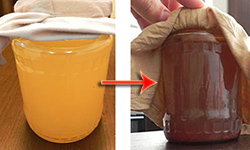
Gently dipping a spoon somewhere around the edge of the “mother” where it touches the container, gather just enough of the vinegar for a taste. If your ferment tastes quite acidic or pleasant to you and you are ready to bottle your vinegar
Filter the liquid through several layers of fine cheesecloth or filter paper—a coffee filter works well for this. This removes the mother of vinegar, preventing further fermentation or spoilage of the product.
If the vinegar highly acidic and you find it almost too potent you can simply add some spring or filtered water to mellow the acidity.
Raw apple cider vinegar doesn’t go bad, but if you leave it for a long time, another mother culture will likely form on top. This is fine, just strain it again and dilute with a bit of water if the taste has become too strong. If you want to prevent this from happening you have to pasteurize the raw vinegar.
Learning how to do stuff on your own its an important skill (and could be a way of life), not only to save money or to stay away from GMO’s, but to better yourself. And in darker times or in time of crisis to be able to support and sustain your family without much outside aid. This is one of the things that I’ve learned from a well-known army officer vet Steve Walker, for whom I have all the respect in the world. Watch his video and learn quite a few efficient and unconventional fast-tips about protecting your family in time of war or social chaos.
Pasteurizing the Vinegar (optional)
Pasteu rizing destroys the living bacteria in the vinegar stopping any more growth, stabilizing the flavor and lengthening shelf life
rizing destroys the living bacteria in the vinegar stopping any more growth, stabilizing the flavor and lengthening shelf life
To pasteurize you vinegar, pour the vinegar into a large stainless steel or enamel coated pot.
Over medium heat bring the vinegar up to 140 degrees and hold it at this temperature for 10 minutes. Be careful not to boil your vinegar. Turn off the heat and allow the vinegar to cool, uncovered. Once it’s cooled, pour the vinegar into your storage container and seal until ready to use.
Caution
Two factors require special attention when making vinegar at home: oxygen supply and temperature. Oxygen is spread throughout the mixture by stirring it daily and by letting air reach the fluid through a cheesecloth filter, which is used in place of a regular lid. The temperature of fermenting cider should be kept between 60 and 80 degrees Fahrenheit (F). Lower temperatures do not always produce a usable vinegar, and higher ones interfere with the formation of the “mother of vinegar”.
Do not use a metal container when making vinegar; acid in the mixture will corrode metal or aluminum objects. Glass, plastic, wood, enamel, or stainless steel containers should be used for making or storing vinegar.
Ingenious Foods People Made During Famines
EMP survival and preparedness guide
What’s the #1 Killer In Any Crisis?
Turning Flour into Hardtack Biscuits With Over 100 Year Shelf Life

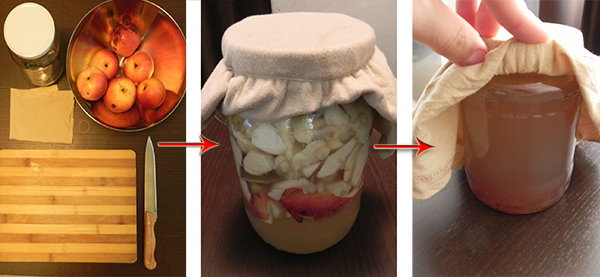














Like it
how do you know if your vinegar is 5% acidity like the store bought stuff?
You can’t know for sure if it’s exactly 5%. You have to taste it and filter it when it has the right acidity for your taste. If it’s to acid mix it with some water. If it’s not acid enough, let it rest for a few more days and then repeat the process.
How much honey or sugar do you use for this much apple? From the photo, it looks like a couple of tablespoons?????
I used one large tablespoon of honey. But it all depends on the quantity. I used a half-gallon jar. This should be the proportion. You can even add double the quantity of honey (will ferment faster), but not less than one tablespoon.
My understanding is that Apple Cider Vinegar with the mother in it is the most healthy kind to use.
Yes! It’s an amazing pro-biotic. For other benefits of vinegar read the first part: http://www.askaprepper.com/how-make-powerful-natural-antibiotic/
Do I leave the Mother in the finished product?
No. If you leave it will ferment again.
When it ferments again, is that a good thing or a bad thing.
Will it just make the acidity stronger if it ferments again?
My neighbor gives me apple peelings for my bunnies. I will try this at the next opportunity. Thx
Missy, this is off topic from ACV but if your neighbor is sharing her apple peelings with you for your rabbits is she expecting to share the rabbit meat? What about when the SHTF can you trust her?
This is neat! My daughter just sent me a question about commercially-made distilled vinegars, and it turns out it’s legal to use petroleum products in making vinegar — even to label it “organic!”
And this doesn’t even look that hard! (except for keeping my space between 60 and 80 degrees in deep winter!)
Seems a bit odd to remove the “mother” from the vinegar. We’ve been making since my mother was a child and never removed it. Just as if you were to buy organic acv in the store, it should have a bit of mother. Or as we call it dirty.
My mum & gran-mum did not remove it.
Once you have a mother blob, you can keep it working. Pour off/decant some of the new made ACV. Add an equal amount of Filtered Apple Cider Vinegar and some more sweetener. I’m currently making “cheater” ACV. A gallon of Filtered less one cup. Add one cup ACV with the mother and white sugar or whatever sweetener you are using.
Can you use dehydrated apples as well? Having apple trees are nice, but not always an option. I live in the Southwest, so they are not as plentiful. So using my food stores in a SHTF situation to make ACR is a possibility.
GREAT AND VERY USEFUL ARTICLE! THANKS!!!!!
I tried making ACV starting with unpasteurized cider. The acidity is right (3.1 compared to the store brand at 3.0) but the cider still smells very sweet. Has this happened to anyone else? Is there any fix to it?
I was going to try the same thing but I don’t see any comments to your question. Did the apple cinder turn to vinegar and if so, what did you do to the apple cider to turn it tovinegar?
Hi everyone!
May I use maple syrup instead of honey and how much please? Process is it different?
After you strain the ACV does the liquid then form bubbles on top?
Hello
I started the process of making my acv in late August. The jar is full of healthy live stuff but After 2 months it’s still rather sweet and not so much acetic. I took away the apple scraps approximately after 4 weeks. For now I’ll leave it to rest but I can’t understand why it’s taking so long of if it will ever turn to vinegar.
I’ve tried to make this ONCE! It’s been sitting for nearly 6 months now and there is no acidic smell like vinegar though it seems to have 2 ‘mother’s” and the beginning of a 3rd. I hesitantly tasted (off my fingertip) just a bit of it and it tasted nothing like vinegar. There was no acidity at all and the smell, though not totally unpleasant, again, didn’t smell anything like vinegar. I dumped it out just now. I’ll try again. Maybe that’s the way it’s SUPPOSED to be? I don’t know.
Is it possible to can the vinegar in jars?
Use organic apple, NOT the waxed sterile ones from the grocery. Be sure to stir it daily, I did not read that far the first time.
After straining it needs to…
“allow the alcohol to transform into acetic acid by the action of acetic acid bacteria.” quote from the article
My first batch, I did not use sugar, just my apple scraps, from making homemade apple sauce ( delicious) covered it with a coffee filter and rubber band, stirred2-3 times a day for about 4 weeks, then let it sit for another 2 and it turned out great for me. Not as sour as the store bought stuff, but better flavor. My second is working right now, I used quartered apples a little sugar and a small amount of the first one. I smelled the yeast more in this one but less of a mother. it is getting acidic just like the first one. I taste every so often to see how it is doing. It could be a matter of personal taste. I store it in my old vinegar jars from the store. A quart at a time.
Does anyone else just want to drink this? I ove the smell of fresh apple cider vinegar.
Once the ACV is made to my liking, do I store it on the fridge or just a cool dry dark place? Also, what is the shelf life?how long will it last ?
WHY would you ever want to pasteurize your vinegar? That would cook out all of the benefits of having a homemade vinegar. Cooking kills the beneficial enzymes that make it healthy. Same with honey; never cook with it or you are just making an expensive sugary product.